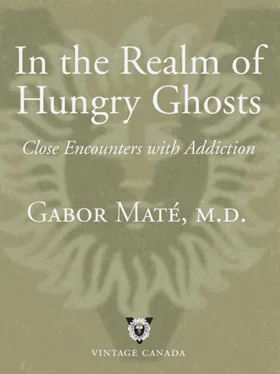In earlier military conflicts relatively few U.S. military personnel succumbed to addiction. What distinguished the Vietnam experience from these wars? The ready availability of pure heroin and of other drugs is only part of the answer. This war, unlike previous ones, quickly lost meaning for those ordered to fight and die in the faraway jungles and fields of Southeast Asia. There was too wide a gap between what they’d been told and the reality they witnessed and experienced. Lack of meaning, not simply the dangers and privations of war, was the major source of the stress that triggered their flight to oblivion.

Drugs, in short, do not make anyone into an addict, any more than food makes a person into a compulsive eater. There has to be a preexisting vulnerability. There also has to be significant stress, as on these Vietnam soldiers—but, like drugs, external stressors by themselves, no matter how severe, are not enough. Although many Americans became addicted to heroin while in Vietnam, most did not.
Thus, we might say that three factors need to coincide for substance addiction to occur: a susceptible organism; a drug with addictive potential; and stress. Given the availability of drugs, individual susceptibility will determine who becomes an addict and who will not—for example, which two from among a random sample of ten U.S. GIs in Vietnam will fall prey to addiction.
In the rest of this section we’ll investigate the roots of that susceptibility.
CHAPTER 13

A Different State of the Brain
“Addiction is mysterious and irrational,” writes the psychiatrist Robert Dupont, who was the first director of the [U.S.] National Institute on Drug Abuse and White House drug czar under Presidents Nixon and Ford. 1
Perhaps another view is possible. Addiction is irrational and at times the behaviour of addicts seems mystifying even to themselves. But what if we listen to addicts and hear their life histories as we began to do in the first part of this book? And what can we learn if we survey the brilliant and extensive scientific literature that has examined addiction from almost every conceivable angle? I believe that if we look with an open mind at this phenomenon called addiction, the sense of mystery will be replaced by an appreciation of complexity. We are left, above all, with awe for the amazing workings of the human brain and with compassion for those mesmerized by their addictive urges.
What does the research tell us?

As we have seen, laboratory animals can be led into drug and alcohol addiction. Hooked up to the appropriate apparatus and allowed unlimited access, many rats will self-administer intravenous cocaine to the point of hunger, exhaustion and death. Researchers even know how to make some laboratory creatures—rats, mice, monkeys and apes—more vulnerable to addiction by genetic manipulations or by interference with prenatal and post-natal development.
Animal experiments, some truly disturbing to read in detail, have allowed for finely tuned research into the relationships between brain circuitry, behaviour and addiction. Through new imaging methods we’ve been able to glimpse the human brain in action under the immediate influence of drugs and after long-term drug use. Radioactive techniques and magnetic frequencies enable researchers to measure blood flow to the brain and to gauge the level of energy used by brain centres during various activities or certain emotional states. Electroencephalograms (EEGs) have identified abnormal electrical brainwave patterns in some young people who are at greater-than-normal risk for alcoholism. Scientists have looked at the chemistry of the addicted brain, at its neurological connections and its anatomical structures. They’ve analyzed the workings of molecules, the membranes of cells and the replication of genetic material. They’ve investigated how stress activates the brain circuitry of addiction. Large-scale studies have examined what hereditary predispositions might contribute to addiction and how early life experiences may shape the brain pathways of addiction.
There are controversies, as we shall see, but everyone agrees that on the basic physiological level, addiction represents “a different state of the brain,” in the words of physician and researcher Charles O’Brien. 2The debate is over just exactly how that abnormal brain state arises. Are the changes in the addicted brain purely the consequence of drug use or is the brain of the habitual user somehow susceptible before drug use begins? Are there brain states that pre-dispose a person to become addicted to drugs or to behaviours such as compulsive sexual adventuring or overeating? If so, are those predisposing brain states induced mostly by genetic inheritance or by life experience—or by some combination of both? The answers to these questions are crucially important for the treatment of addiction and for recovery.
The drug-addicted brain doesn’t work in the same way as the nonaddicted brain and when imaged by means of PET scans and MRIs, *14it doesn’t look the same. An MRI study in 2002 looked at the white matter in the brains of dozens of cocaine addicts from youth to middle age, in comparison with the white matter of nonusers. The brain’s grey matter contains the cell bodies of nerve cells; their connecting fibres, covered by fatty white tissue, form the white matter. As we age, we develop more active connections and therefore more white matter. In the brains of cocaine addicts the age-related expansion of white matter is absent. 3Functionally, this means a loss of learning capacity—a diminished ability to make new choices, acquire new information and adapt to new circumstances.
It gets worse. Other studies have shown that grey matter density, too, is reduced in the cerebral cortex of cocaine addicts—that is, they have smaller or fewer nerve cells than normal. A diminished volume of grey matter has also been shown in heroin addicts and alcoholics, and this reduction in brain size is correlated with the years of use: the longer the person has been addicted, the greater the loss of volume. 4In the part of the cerebral cortex responsible for regulating emotional impulses and for making rational decisions, addicted brains have reduced activity. In special scanning studies these brain centres have also exhibited diminished energy utilization in chronic substance users, indicating that the nerve cells and circuits in those locations are doing less work. When tested psychologically, these same addicts showed impaired functioning of their prefrontal cortex, the “executive” part of the human brain. Thus, the impairments of physiological function revealed through imaging were paralleled by a diminished capacity for rational thought. In animal studies, reduced nerve cell counts, altered electrical activity and abnormal nerve cell branching in the brain were found after chronic cocaine use. 5Similarly, altered structure and branching of nerve cells has been seen after long-term opiate administration and also with chronic nicotine use. 6Such changes are sometimes reversible but can last for a long time and may even be lifelong, depending on the duration and intensity of drug use.

To write about the biology of addiction one must write about dopamine, a key brain chemical “messenger” that plays a central role in all forms of addiction. An imaging study of rhesus monkeys published in 2006 confirmed previous findings that the number of receptors for dopamine was reduced in chronic cocaine users. 7Receptors are the molecules on the surfaces of cells where chemical messengers fit and influence the activity of the cell. Every cell membrane holds many thousands of receptors for many types of messenger molecules. Cells receive input and direction from other parts of the brain and the body and from the outside by means of messenger-receptor interactions. If it wasn’t for their ability to exchange messages with their environment, cells could not function.
Читать дальше














